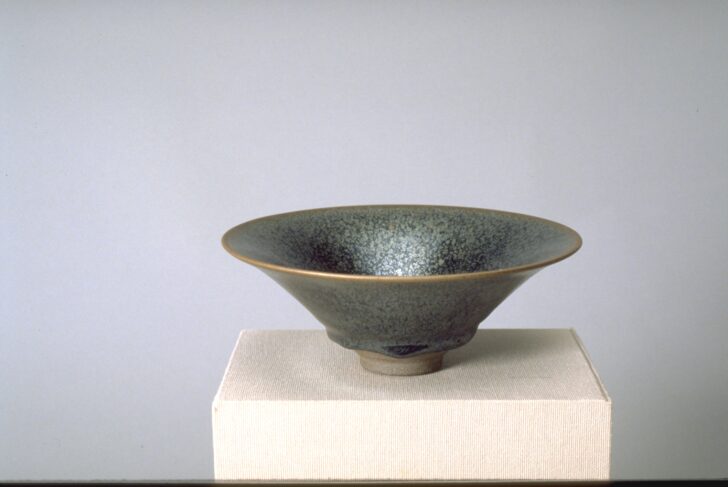Tea bowl with flaring rim
Hara Masao

Description
2. Arao Tsunezô
Japan, active 1950–1970
Tea bowl
Showa period (1926–1989)
circa 1960
Stoneware with tenmoku glaze
Museum purchase, 1965/1.155
3. Hara Masao
Japan, 20th century
Tea bowl
Showa period (1926–1989)
circa 1975–80
Stoneware with oil spot tenmoku glaze
Gift of Mr. Masao Hara, 1980/2.164
4. Katô Kôbei
Japan, 1893–1982
Narrow-necked bottle
Showa period (1926–1989)
circa 1950–63
Stoneware with oil spot tenmoku glaze
Gift of the artist, 1963/2.66
Deep black and brown glazed tenmoku ware was highly prized in the Imperial court of the Chinese Northern Song dynasty (960–1127). Produced in the Jian kilns in Fujian, this type of pottery was brought to Japan by Zen monks who had studied in Chinese monasteries in the twelfth century; later it was treasured by generations of Japanese tea practitioners. The many variations of these wares—which have names such as yuteki (oil spot) tenmoku and konoha (leaf) tenmoku—require an extremely careful calculation of firing temperatures for successful glazing. The works on display are the result of a long process of trial and error by potters trained to achieve tenmoku variations and other virtuosic effects.
(Turning Point exhibition, Spring 2010)
During the Muromachi period in Japan (1333–1573), trade with China was often handled through the agency of Zen Buddhist monks, who had learned Chinese through their religious studies. Several Zen monks traveled in person to the great Chan monasteries in southeast China and on their return brought back not only new Buddhist teachings but also the material and visual culture of late Song and Yuan dynasty China. As a consequence, the Zen monasteries of Kyoto became centers of Chinese learning and promoted the study of Chinese poetry, painting, and the art of drinking tea. The tea bowls the Japanese monks discovered in southeast China were the black glazed ware from the Jian kilns, known in Japan as tenmoku. The most highly prized varieties of tenmoku were those with the descriptively named "iridescent", "oil spot", and "hare’s fur" glazes. Modern potters in both China and Japan continue to work in these glazes to satisfy the contemporary market for tea wares. This tea bowl is an example of modern tenmoku ware.
---
Deep black and brown glazed tenmoku ware was highly prized in the Imperial court of the Chinese Northern Song dynasty (960–1127). Produced in the Jian kilns in Fujian, this type of pottery was brought to Japan by Zen monks who had studied in Chinese monasteries in the twelfth century; later it was treasured by generations of Japanese tea practitioners. The many variations of these wares—which have names such as yuteki (oil spot) tenmoku and konoha (leaf) tenmoku—require an extremely careful calculation of firing temperatures for successful glazing. The works on display are the result of a long process of trial and error by potters trained to achieve tenmoku variations and other virtuosic effects.
(Turning Point exhibition, Spring 2010)
Subject Matter:
Japanese monks brought teabowls that made use of this glazing technique from the Jian kilns of southeast China, known in Japan as tenmoku. The most highly prized varieties of tenmoku were those with the descriptively named "iridescent", "oil spot", and "hare’s fur" glazes. This tea bowl is an example of modern tenmoku ware.
Physical Description:
Footed stoneware bowl with tenmoku 'oil spot' glaze and unglazed foot. The bowl black tenmoku glaze blends to brown at the flared rim.
Usage Rights:
If you are interested in using an image for a publication, please visit https://umma.umich.edu/request-image/ for more information and to fill out the online Image Rights and Reproductions Request Form.